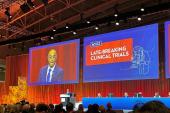Pacemaker Doesn’t Harm Outcomes of Alcohol Septal Ablation for Obstructive HCM
“Now we know that we don't have to worry so much about the risk of PPM” after the procedure, Josef Veselka says.

Over the long term, patients with obstructive hypertrophic cardiomyopathy (HCM) who require a permanent pacemaker after alcohol septal ablation (ASA) fare just as well as those who don’t, a multinational registry suggests.
NYHA functional class and survival were similar in the two groups through a mean follow-up of 5 years after ASA, Josef Veselka, MD, PhD (Charles University, University Hospital Motol, Prague, Czech Republic), and colleagues report in a study published online this week in JACC: Cardiovascular Interventions.
But patients with versus without a PPM had greater reductions in LV outflow gradient, likely related to more-aggressive procedures involving larger volumes of alcohol, and less need for additional septal reduction therapy with a repeat ablation or surgical myectomy.
“We knew that approximately 10% of patients need PPM after ASA,” Veselka told TCTMD via email. “The key information of our study is the finding that patients with PPM have a prognosis comparable to other ASA patients without PPM at mid- to long-term follow-up.”
Veselka highlighted the trade-offs cardiologists must consider when choosing a treatment strategy for patients with obstructive HCM.
“Before performing ASA, cardiologists should determine a strategy for the procedure and answer two questions. First, do I want to be aggressive and inject a higher dose of alcohol even if a complete heart block develops during the injection? Second, do I know exactly (by TTE and/or CMR) where I want to ablate and how much alcohol I want to deliver?” he said.
“For many cardiologists, this should mean a paradigm shift from treating every patient equally (eg, using the same dose of alcohol in all patients or ablating only one septal branch each time). ASA should be tailored to each patient,” he said. “Now we know that we don't have to worry so much about the risk of PPM after ASA.”
Pacemaker Impact
ASA is an alternative to surgical myectomy for septal reduction therapy in symptomatic patients with obstructive HCM, with observational data suggesting similar outcomes with either approach. However, perioprocedural atrioventricular block requiring implantation of a PPM is a known complication of ASA, occurring in 7% to 20% of cases. There are limited data on how these patients do over the long term.
To help fill that gap, Veselka and colleagues turned to the Euro-ASA registry, which collected data from six European countries. The analysis included 1,814 patients who underwent ASA for obstructive HCM between 1996 and 2021 and were followed for a mean of 5 years (median 4 years).
Overall, 9.4% required implantation of a PPM during the first 30 days after ablation due to high-grade atrioventricular block; the vast majority (88%) were placed during the first postprocedural week. Another 3% of patients received a PPM during follow-up. Predictors of receiving a PPM were worse NYHA functional class, older age, lower LVEF, lower interventricular septum thickness, bundle branch block before ablation, and greater alcohol dose during a first ablation.
The investigators used propensity-score matching to account for differences between the PPM and non-PPM groups, resulting in a matched cohort of 278 patients (139 patient pairs). Mean patient age was roughly 60, and 51% were women.
After matching, there were no long-term differences in NYHA functional class (mean 1.5 in both groups; P = 0.99) or survival. The rate of freedom from all-cause mortality in the PPM group was 98% at 1 year, 89% at 5 years, and 78% at 10 years, with comparable rates in the non-PPM group (log-rank P = 0.47).
Compared with the non-PPM cohort, patients with a PPM had a lower LV outflow gradient at the end of follow-up (mean 12 vs 17 mm Hg, P = 0.002), a greater decrease in LV outflow gradient (mean 81% vs 72%; P < 0.01), and a slightly lower (but still normal) LVEF (mean 64% vs 66%; P = 0.022). They were also less likely to have NYHA class III/IV symptoms at the end of follow-up (8% vs 18%; P = 0.021) and to require reintervention (log-rank P = 0.02).
Veselka attributed those differences to use of more-aggressive procedures in the PPM group. On average, ablation involved about a 10% higher dose of alcohol in patients who went on to receive a PPM.
Cardiologists and patients can choose whether they should seek the benefits of ablation with higher alcohol doses at the cost of more atrioventricular block or go with a less-aggressive procedure with fewer complications, Veselka said. “In clinical practice, the decision-making is complex, as the septal anatomy, septal thickness, localization of hypertrophy, patient age, symptoms, quality of life, and patient expectations must be taken into account,” he said, noting that a residual LV outflow gradient above 30 mm Hg has been associated with increased mortality.
Much-Needed Long-term Data
In an accompanying editorial, Andres Pineda, MD (University of Florida College of Medicine – Jacksonville), and Andrew Wang, MD (Duke University, Durham, NC), say the study “provides further evidence that with current techniques and in the hands of experienced operators, ASA provides excellent short- and long-term survival, which is at least comparable to septal myectomy and not adversely affected by the need of PPM implantation.”
The two key pieces of information were the longer-term mortality rates and the updated incidence of pacemaker implantation, Pineda told TCTMD.
The study doesn’t really change considerations around patient selection or performance of ASA, as operators already try to use the least amount of alcohol needed to achieve a good result, Pineda said.
Moreover, even though older patients were more likely to require a pacemaker, “those are the typical patients we manage with alcohol ablation. A patient who is younger and in better shape, they’ll probably undergo surgical myectomy,” Pineda said. He added that the study “gives us more data to inform patients [about] the risks and expectations after alcohol septal ablation.”
There remain unanswered questions to be addressed by future studies, Pineda said, pointing to the need to better understand the long-term risks of nonfatal complications associated with pacemakers, as well as impacts on functional capacity and quality of life, and the influence of operator and hospital experience on outcomes. A prior study from Veselka’s group demonstrated that more-experienced centers implanted fewer PPMs after ASA.
But the biggest remaining need in terms of research, Pineda said, is a randomized comparison between ASA and surgical myectomy in patients with obstructive HCM.
“However, in the absence of randomized control clinical trials, a significant body of evidence from observational studies, including this report by Veselka et al, demonstrate excellent outcomes after ASA representing a valid treatment option for patients with HCM,” he and Wang write in their editorial.
There are many areas that can be addressed in future studies, Veselka agreed, but he said “the main question is how to select the patients for ASA, for myectomy, and, in the future, for myosin inhibitors.”
Todd Neale is the Associate News Editor for TCTMD and a Senior Medical Journalist. He got his start in journalism at …
Read Full BioSources
Veselka J, Liebregts M, Cooper R, et al. Outcomes of patients with hypertrophic obstructive cardiomyopathy and pacemaker implanted after alcohol septal ablation. J Am Coll Cardiol Intv. 2022;Epub ahead of print.
Pineda AM, Wang A. New pacemaker implantation after alcohol septal ablation: how sharp is the double-edged sword? J Am Coll Cardiol Intv. 2022;Epub ahead of print.
Disclosures
- Pineda and Veselka report no relevant conflicts of interest.
- Wang reports being a consultant and speaker for Bristol Myers Squibb.



Comments